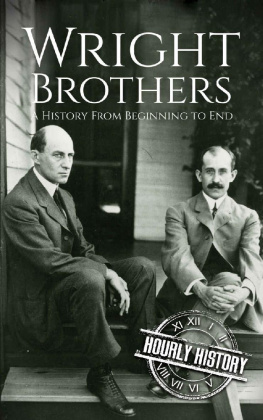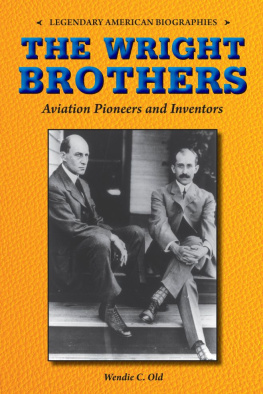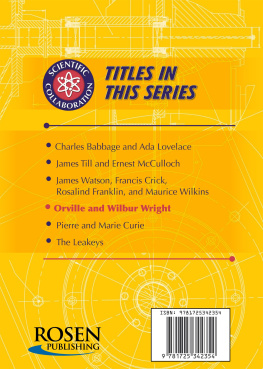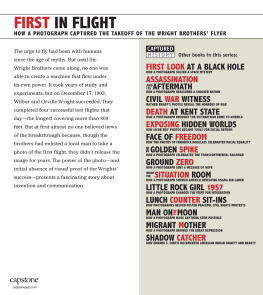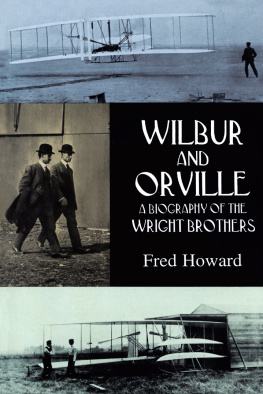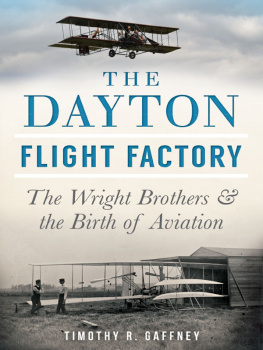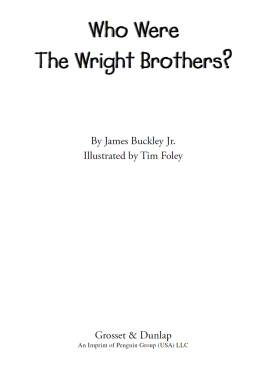Acknowledgments are a special problem when a book has been in the making as long as this one, but there is no doubt where my greatest debts lie. Any author assessing the Wright brothers must be forever grateful to a pair of early scholars, Marvin W. McFarland and Charles Harvard Gibbs-Smith. That is especially true in my caseboth were friends, guides, and mentors.
The members of the Wright family have extended themselves on my behalf for over ten years. The best I can offer is the book itself, along with my thanks, to: Ivonette Wright Miller and Harold Miller; Susan and Horace Wright; Wilkinson and Marion Wright. Thanks also to John Jameson, who gave his time generously over the telephone. Mrs. Elizabeth Rehling, daughter of Agnes Osborn and an old friend of the family, shared her mothers memories, and her correspondence with Katharine Wright.
Rick Young, a fellow Wright scholar, has for years been willing to drop everything for a discussion of some obscure point relating to the Wrights. He invited me to assist in building a replica of the 1902 glider. The hours spent helping to fly that machineand lugging it back up the slope for the next tryhave added to my understanding of what the Wrights accomplished, and how they lived and worked on the Outer Banks. For that, and for his friendship, my thanks. Ken Kellett, who built and flies a replica of the 1903 airplane, also provided an opportunity to crew that machine.
Howard Wolko, special assistant for technology with the Aeronautics Department of the National Air and Space Museum, helped me to understand how an airplane flies, and how the Wrights designed their machines; he also allowed me to serve as his partner in a recreation of the 1901 wind-tunnel experiments. Others who have made important contributions include Eugene Husting, Peter Jakab, Richard Hallion, Dr. Douglas Robinson, and John Gillikin.
As always, I am indebted to librarians. Patrick Nolan and his colleagues at the Wright State University Archives deserve special thanks for their assistance and courtesy. The staff of the Dayton and Montgomery County Public Library also went far out of their way to help. In addition, my thanks to: the staff of the Manuscript Division, Library of Congress; the Library and Archives staff of the National Air and Space Museum; the crew at the Library of the National Museum of American History; and Bill Diess and his colleagues at the Smithsonian Archives.
It is customary to include ones wife and children in the list of acknowledgments. Those who have not lived through the process of writing a book may not realize the price family members pay for the finished product. Nancy, Bruce, Abby, and Natethanks.
Tom D. Crouch
Fairfax, Virginia
December 30, 1989
Much ink has been spilled in attempts to portray Wilbur and Orville Wright and their achievements. What follows is intended to introduce the reader to the major sources consulted during the preparation of The Bishops Boys, and to offer suggestions for those interested in further reading.
GENERAL:
Arthur G. Renstrom, Wilbur and Orville Wright: A Bibliography (Washington, D.C.: Library of Congress, 1968), serves as a starting point for any discussion of the Wright literature. The 2,055 items catalogued represent the vast bulk of what was said about Wilbur and Orville prior to 1968. The bibliography prepared by Dominick Pisano of the National Air and Space Museum for Richard P. Hallion, ed., The Wright Brothers: Heirs of Prometheus (Washington, D.C.: Smithsonian Institution Press, 1978), is a useful guide to materials published since Renstrom.
MANUSCRIPTS:
The majority of materials relating to Wilbur and Orville Wright are held by two repositories: the Manuscript Division of the Library of Congress, and the Wright State University Archives, Dayton, Ohio. For the most part, letters, diaries, the great bulk of the brothers correspondence, and other material relating to the invention of the airplane will be found in the Library of Congress. The fine collection at Wright State consists of what was once, incorrectly, regarded as the less important family and legal material. Patrick A. Nolan and John Zamonski, The Wright Brothers Collection: A Guide to the Technical, Business and Legal, Genealogical, Photographic, and Other Archives at Wright State University (New York: Garland Publishing, 1977), is a very useful guide to that collection. A much shorter aid is available for Wright materials at the Library of Congress. An additional smaller collection of original Wright material can be found at the Franklin Institute.
The Dayton Room of the Dayton and Montgomery County Public Library maintains the only complete collection of newspapers published by the brothers, as well as several fine unduplicated scrapbooks, and scattered materials relating to the family and to Miltons church career. Other major scrapbook collections include those in the Wright Collection at the Library of Congress, and the Bell and Langley scrapbooks in the National Air and Space Museum Library. One interesting single scrapbook is in Orvilles library at Hawthorn Hill.
PHOTOGRAPHS:
The original glass plate negatives taken by Orville Wright as a record of the invention of the airplane are in the Library of Congress, which also holds one of the finest general photo collections relating to the brothers. A set of microfilm cards, including all the original glass plate images, is available for sale through the Library. The National Air and Space Museum Archive has another fine photo collection, all of which are included on a single laser-read video disc sold by the museum. The Wright State University is the third major repository of Wright images, many of them family snapshots not available elsewhere. Arthur G. Renstrom, Wilbur and Orville Wright: Pictorial Materials, a Documentary Guide (Washington, D.C.: Library of Congress, 1982), lists virtually all known photographs of the brothers except for those covered in Nolan and Zamonski, The Wright Brothers Collection.
Film of the Wrights and their machines is available in a number of repositories. The best collections are at the National Archive Motion Picture Branch; the USAF Central Audio-Visual Depository, Norton Air Force Base, and the National Air and Space Museum, Washington, D.C.
PRINTED PAPERS:
Marvin W. McFarland, ed., The Papers of Wilbur and Orville Wright: Including the Chanute-Wright Letters and Other Papers of Octave Chanute (New York: McGraw-Hill, 1953), 2 vols., and Fred C. Kelly, ed., Miracle at Kitty Hawk: The Letters of Wilbur and Orville Wright (New York: Farrar, Straus & Young, 1951), reproduce the bulk of the useful manuscript material on the invention of the airplane. The Papers, in particular, represent one of the finest jobs of historical editing in this century.
BIOGRAPHIES:
There are seven noteworthy biographies of Wilbur and Orville Wright:
John R. McMahon, The Wright Brothers: Fathers of Flight (Boston: Little, Brown, 1930).
Fred C. Kelly, The Wright Brothers: A Biography Authorized by Orville Wright (New York: Harcourt, Brace, 1943).
Elsbeth E. Freudenthal, Flight into History: The Wright Brothers and the Air Age (Norman, Okla.: University of Oklahoma Press, 1949).
John Evangelist Walsh, One Day at Kitty Hawk: The Untold Story of the Wright Brothers and the Airplane (New York: Crowell, 1975).
Rosamond Young and Catharine Fitzgerald, Twelve Seconds to the Moon: A Story of the Wright Brothers (Dayton, Ohio: The Journal Herald, 1978).
Harry Coombs with Martin Caidin, Kill Devil Hill: Discovering the Secret of the Wright Brothers (Boston: Houghton Mifflin, 1979).


